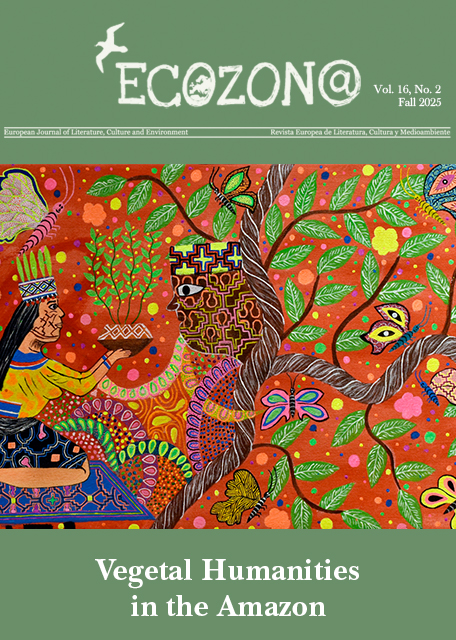<b>Different Shades of Green: A Dark Green Counterculture in Ted Hughes's <i>Crow </i></b>// Diferentes tonos de verde: la contracultura verde oscuro de <i>Crow</i>, de Ted Hughes
DOI:
https://doi.org/10.37536/ECOZONA.2013.4.1.497Palabras clave:
Nature and religion, spirituality, Christianity, science and technology, environmentalism, Naturaleza y religión, espiritualidad, Cristianismo, ciencia y tecnología, ecologismoResumen
Abstract
This essay argues that Crow, a collection of poems by Ted Hughes published in 1970, forms part of a countercultural movement that began to emerge in the 1960s and that continues to find new forms in the current century. In the form it takes in Crow, this movement protests against a relationship between humans and nature based on a primarily Christian world view combined with what it considers an exaggerated belief in science and technology. This combination and its relation to environmental crisis was first addressed by Lynn White in his classical article from 1967, “The Historical Roots of our Ecologic Crisis”. This analysis attempts to demonstrate that the Crow poems, written in the years immediately following the publication of White’s article, express a similar set of ideas in poetic form. Hughes goes a step further than White, and envisions an alternative, spiritual rather than religious, framework for the nature-human relationship. This alternative is characterised as part of a counterculture described by Bron Taylor in Dark Green Religion. According to Taylor, dark green religion defines a variant of environmentalism based on a spiritual view of nature (similar but not identical to deep ecology). This essay suggests that Hughes’s Crow is a version of this counterculture.
Resumen
Este ensayo argumenta que Crow, una colección de poemas de Ted Hughes publicada en 1970, forma parte del movimiento contracultural que comenzó a surgir en la década de los 60 y que sigue encontrando nuevas formas en el siglo actual. En la forma que adopta en Crow, este movimiento protesta contra una relación entre hombre y naturaleza basada en una visión del mundo fundamentalmente Cristiana combinada con lo que considera una creencia exagerada en la ciencia y la tecnología. Fue Lynn White quien en su artículo de 1967, "Las raíces históricas de nuestra crisis ecológica", abordó por primera vez esta combinación y su relación con la crisis medioambiental. Este análisis intenta demostrar que los poemas de Crow, escritos en los años inmediatamente siguientes a la publicación del artículo de White, expresan ideas similares pero de forma poética. Hughes va más allá que White y concive un marco alternativo, más espiritual que religioso, para la relación ser humano-naturaleza. Esta alternativa se caracteriza por ser parte de la contracultura descrita por Bron Taylor en Dark Green Religion. Según Taylor, “la religión de color verde oscuro” define una variante del ecologismo basada en una visión espiritual de la naturaleza (similar pero no idéntica a la ecología profunda). Este ensayo sugiere que los poemas de Crow de Hughes son una versión de esta contracultura.
Descargas
Descargas
Publicado
Número
Sección
Licencia
Authors who publish with this journal agree to the following terms:
a) Authors retain copyright and grant the journal right of first publication with the work simultaneously licensed under a Creative Commons Attribution License that allows others to share the work with an acknowledgement of the work's authorship and initial publication in this journal (CC BY-NC for articles and CC BY-NC-ND for creative work, unless author requests otherwise.
b) Authors are able to enter into separate, additional contractual arrangements for the non-exclusive distribution of the journal's published version of the work (e.g., post it to an institutional repository or publish it in a book), with an acknowledgement of its initial publication in this journal.
c) Authors are permitted and encouraged to post their work online (e.g., in institutional repositories or on their website) prior to and during the submission process, as it can lead to productive exchanges, as well as earlier and greater citation of published work (See The Effect of Open Access).










